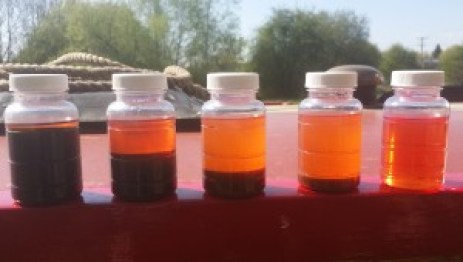What is Fuel Polishing?
The truth is that fuel polishing is just another word for filtration. Dirty fuel which is dark and opaque is put through a filter in the fuel polishing system and comes out clear and “sparkling”. So a fuel polishing system is simply a filtration system.
[slideshow_deploy id=’246′]
Does Contamination Matter?
Hopefully it is obvious to everyone that having tank rust and other dirt in your fuel is bad for the engine. Even small particles of rust increase the amount of wear on an engine and reduce its useful life, its efficiency and its reliability.
Contamination from the “diesel bug” has recently become a problem because of the reduced amount of sulphur (which inhibited the growth of microbes) in diesel and the increased quantity of bio-fuel contained in standard diesel products. Don’t take our word for it have a look at the Wikipedia entry on Diesel
Are all Fuel Polishing Systems basically the same?
The short answer is NO. Some systems filter large quantities of fuel very quickly, some will filter small quantities rather more slowly. Not only is there a difference in speed but much more importantly there is a significant variation in the quality of the cleaned fuel. A lot of competitors equipment cannot filter out water. That means the diesel bug will continue to manifest 260,000 times every 6 hours leaving your engine, fuel pump, diesel heating systems at a high risk. Plus the cleaning will have cost you money for a job that’s not been carried out correctly.
So how do we know if fuel is adequately cleaned?
There are two main measures of the contamination of fuel – particle size and water content.
Fuel that has been “polished” and still contains particles greater in size than about 5 microns still presents a significant risk to your equipment in terms of increased wear and tear.
Even if the free water (the water you can see) has been removed from the fuel there is still water suspended in the fuel itself. This water is still available to the bacteria that can grow in your tank so it is important to remove as much of this water as possible. This level of water is measured in parts per million (ppm). Tankbusters equipment can filter to below 1 micron and remove water to 100ppm. “THAT’S FUEL CLEANING AT ITS BEST”
What affects the speed of Fuel Polishing Systems
Contaminated fuel is pushed through filters using a pump – a finer filter is harder to force contaminated fuel through so often higher quality results take longer to achieve. The other factor is the pressure that the pump can generate. A higher pressure will result in more rapid filtration. So high speed and high quality filtration requires high pressure and a fine filter. When dealing with very large volumes of fuel, powerful equipment is called for. For smaller applications which are less time critical, less power is required, however, in both cases the filter size is critical in determining the quality of the end result.
Tankbusters Fuel Polishing System
We provide a wide range of equipment for large and small applications. Our systems filter out particles to below 1 micron can and commonly the water content in the filtered fuel is lower than fuel directly from refineries – often well below 100 ppm. (Parts per million) With water levels this low the diesel bug has a vastly reduced ability to reproduce.
Few, if any, of our competitors achieve this level of cleaning and we believe that the quality of our equipment speaks for itself.
Get clean and stay clean
Cleaning the tank is the first step towards good ‘housekeeping’. Switching on the Tankbusters equipment and giving your dirty diesel and tank a good cleaning & filtering will take out whatever contamination is in your tank and will maintain red or white diesel in a clean, dry condition with the result that your engine will run more smoothly and give better performance.
What about diesel additives?
Diesel treatment additives may be used to help prevent the build up of diesel bug contamination (more information about diesel bug here). They may market themselves as a “diesel bug killer” or a “diesel bug treatment”. What they don’t do however is get to the root cause of the problem – water and contamination in the tank. They also do nothing at all about heavy contaminants in fuel and do not remove existing dead diesel bug remains.
In addition to this they need to be used very regularly – at every filling of the tank with fresh diesel otherwise the fresh fuel is at risk of diesel bug contamination again.
So what is the answer? By cleaning your Tank & Fuel to below 1 micron and removing water to below 100ppm (parts per million). You now have a clean tank and fuel. Now you can use the Tankbusters Water removal bag. Designed to sit at the bottom of your tank, the bag will absorb water from condensation and fuel each time you refill your tank and also allow you to monitor the conditions at the bottom of your tank- once full the bag can be replaced to continue it’s work. Once the tank and fuel are clean we recommend the use of Tankbusters additive- this contains a biocide to inhibit diesel bug growth and give you confidence in the quality of your fuel. Our year round additive additionally protects the octane rating of your fuel which is ideal for those who use diesel at a slow rate (meaning that diesel will sit in the tank for a long time).
That’s Fuel Cleaning At Its Best”
Contact us for further information.


